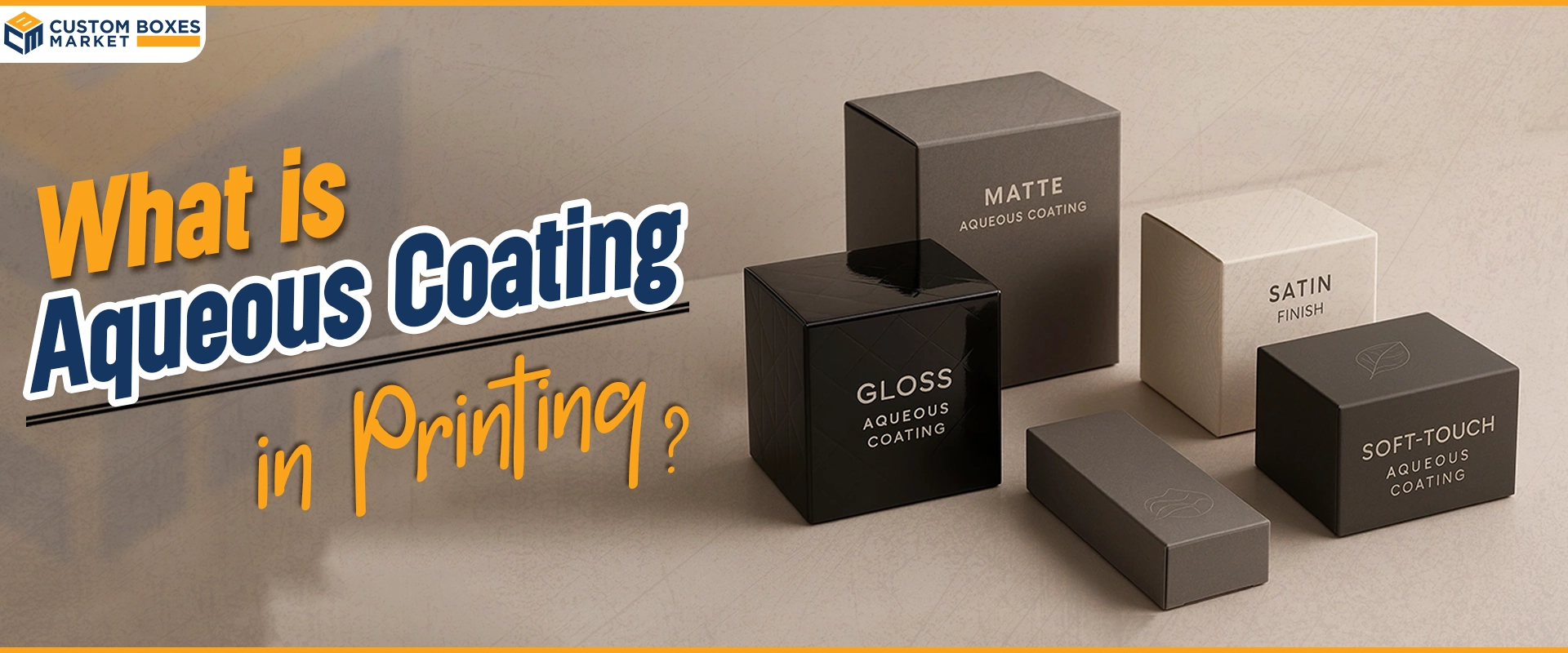How does it feel when you put so much effort into getting your packaging customized but its final appearance is ruined with scratches and scuffs? The design was perfect and so were the colours. Then what went wrong? Know that you missed a seemingly extra but very important detail. You did not apply an aqueous coating to your box. It is a water-based coating that acts as a protective layer for the packaging. Continue reading and find out about it in detail.
What Is Aqueous Coating?
There are many types of protective coatings and aqueous coating is one of its types. It is a water-based finish applied to printed material to protect the surface and enhance appearance. The aqueous coating is applied because it dries quickly and provides resistance against scratches. Its application elevates the appearance of the box by making its surface smooth.
Aq coating is safe for the environment because its VOC emission is very low. It does not contain harmful chemicals that can degrade the environment. Custom food packaging boxes are preferably coated with water-based coatings because they are not toxic.
How Is It Applied?
A layer of aqueous coating enhances the appearance of the packaging. But then the question arises of how this process is carried out. The answer is that there are some technical processes through which these coatings are applied.
The Flood Concept
A flood coating for an aqueous coating involves applying the water-based aqueous coating to the entire surface of a printed piece. It is not like spot coating which is applied to specific areas only. This process ensures that a uniform layer of water-based varnish is coated.
Inline Application
Aqueous coating in printing is frequently applied inline. This means that it is integrated into the overflow of the printing press. This process is executed as the final step of the press run. The process is speedy and less costly because it eliminates the need for a separate offline application. Application steps are carried out as follows:
-
Printing:
The process begins with printing the documents in full colour using any standard printing process. Aqueous coating is usually applied to custom boxes during offset printing but is not exclusive to it. This can also be used during other printing processes.
-
Coating Unit:
The substrate then travels to the dedicated coating unit on the process after the final ink colour is laid down. This unit is separate from the ink units.
-
Application:
A roll system picks up the water-based coating and transfers it to a rubber blanket. This blanket then applies the coating evenly across the printed sheet. Aqueous coatings are most commonly applied as flood coating.
-
Drying:
The coated sheets immediately pass through a heated air-drying system such as a hot air tunnel or infrared system. This process rapidly evaporates the water in the coating.
-
Curing:
The polymer and resin solids in the coating join when the water evaporates in a process called coalescence. This forms a thin film that protects the surface of the packaging materials.
-
Post-processing
The coating almost dries up instantly. These sheets are then stacked and ready for further post-press processing that involves cutting and binding of the box.
Offline Application
This method uses a separate coating machine. It is not integrated into the printing process as in the inline application. The offline application is better suited for smaller batches of rigid boxes that require a higher degree of customization.
Ink Or Water Fountain Coating
Using a printing press’s ink or a water fountain to apply aqueous coating is a less common method compared to using a dedicated in-line coating unit. Aqueous coating for printing is placed in the ink fountain. The press’s ink rollers then transfer the coating to the printing plate, which then applies the coating to the substrate. This method does not guarantee long adhesion and hence is not commonly used.
What Are The Types Of Aqueous Coating Finishes?
The types of aq coating finishes are usually categorized on the basis of their appearance and texture. You have a good palette of options from which you can choose whatever you deem best for your packaging. The options are:
Gloss Aqueous
The vibrant colours printed on the box are enhanced when a gloss finish is applied. It is commonly applied to folding cartons because of their flexibility. Custom makeup boxes are gloss-coated for enhanced presentation.
Matte Aqueous
If you want your box to give an elegant feel, then this is the perfect finish for you. It produces a low lustre finish which gives a soft feel to the packaging. The non-reflective surface helps conceal small dents.
Satin Aqueous
This finish offers the best of both worlds. Satin aqueous coating is not as lustrous as a gloss finish. Nor is it non-reflective like matte. It makes the box look sophisticated without excessive glare.
Soft Touch Aqueous
The most distinct feature of this coating is the velvety texture it bestows upon the material of the customized packaging. This provides an unforgettable sensory experience to the customers.
Why Choose Aqueous Coating?
It is natural to be curious about why, out of all coating options, you should go for aqueous coating. There are several compelling reasons that make it a favourite in the packaging industry. Some of these include:
- Environmentally Friendly
- Less Costly
- Premium Protection
- Flexibility
- Fast Production Rate
- Enhanced Durability
Aqueous coating printing can be compared to other coating types to find out why it is the best option.
Features |
AQ coating |
UV Coating |
Varnishes |
| Composition | It is a water-based coating that makes it non-toxic | A chemical-based liquid that is instantly cured by ultraviolet (UV) light | A clear ink that can be water- or chemical-based |
| Flexibility | Highly flexible. It makes sure no creases appear | It can crease when folded due to less flexibility | Less flexible than aqueous but more than UV coating |
| Application | Flood coating across the entire sheet | Both flood and spot coating are done for accentuating details | Flood or spot coating with a printing plate |
| Environmental impact | Most eco-friendly because its base is composed of water. It can also be recycled | It needs to be cured to lower its VOC emissions | They may contain certain solvents that might not be recyclable |
| Cost | Affordable | Higher cost because special material is required | Less costly than UV for spot coating |
Concluding Remarks
Everyone wants their packaging to appear the best. What better way there can be to improve the presentation of the custom boxes than getting them aqueous coated? Its water base makes it environmentally friendly and affordable. The application of the aq coating makes the box strong and resistant to scratches. It ensures that you do not get to see any scuffs or fingerprints on the packaging. If you are a brand in Canada that wants durable custom boxes with aqueous coating, you can reach out to Custom Boxes Market to get them at wholesale rates.


